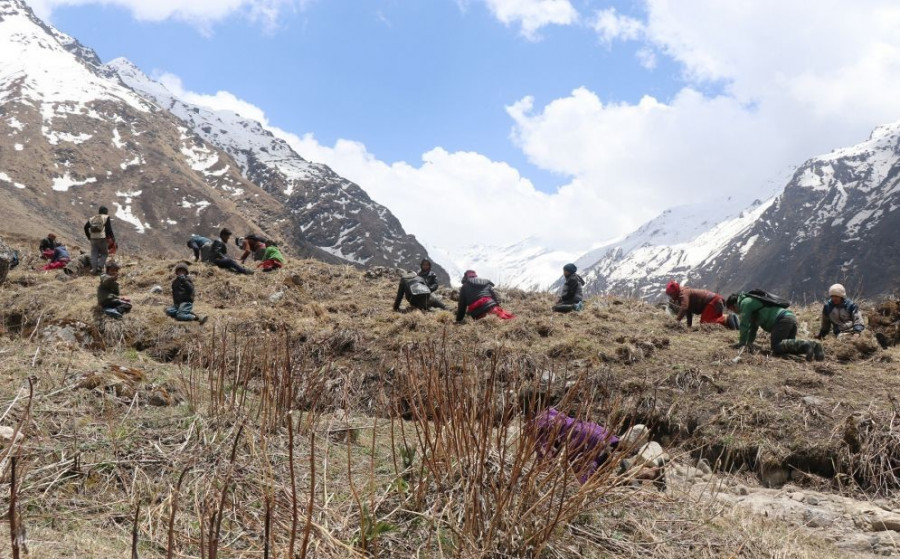National
After delayed and poor harvest, yarsagumba collectors will now have to face depletion concerns
First came the ban in harvesting the fungus due to pandemic fears and now the government has taken note of the IUCN concern of conservation needs for the Himalayan ‘viagra’.
Chandan Kumar Mandal & Basant Pratap Singh
If there had been no pandemic, Tarjun Lama would have by now completed yarsagumba, the caterpillar fungus, harvest for this season. But this year, it was a long wait for Lama, a resident of Saipal Rural Municipality in Bajhang district, before he, and other harvesters, were permitted to travel north.
When villagers like Lama finally managed to go to the highlands, after the lockdown was loosened they found a lot of the fungus (scientific name ophiocordyceps sinensis) but unfortunately almost all of them had rotted and therefore were of little value.
“Of the 400 yarsas I collected, barely 15 were usable,” Lama said. “The prime season to harvest them had long passed.”
Yarsagumba, is formed as a parasitic fungus that grows within a variety of caterpillars in the Himalayan region. It kills the caterpillar and emerges from its body as a thin stem.
The fungus is harvested between May and June, right before the monsoon starts, at elevations between 3,000 and 5,000 metres. Tens of thousands of Nepali villagers flock to the Himalayan foothills in 12 mountain districts in northwestern Nepal to collect the fungus. They travel days to the highlands and live there for up to two months in makeshift tents.
But, like much else in the world, the global Covid-19 pandemic has also affected the yarsa collection.
For impoverished villagers, the lockdown coincided with the most economically important time of the year when they leave their homes for a ‘gold harvest’.
In a good season a family of seven collects around half a kilogram of yarsagumba which can fetch up to a million rupees. There are between 2,000 and 2,500 pieces of the fungus in half a kilogram depending on the size. The size of a yarsagumba varies between 4 and 12 cm in length and 0.14 to 0.4 cm in girth.
The herb is in high demand in China where it is believed to have aphrodisiacal qualities.
Sange Lama, also a harvester from Saipal, said, “Last year, my fellow villagers had collected around 40 kilograms. This year, they have barely managed two.”
In mid-April, during the lockdown, the district Covid-19 Crisis Management Committee in Bajhang decided to put a ban on the collection of the fungus. Chief District Officer Umesh Pandey, who heads the committee, reasoned that allowing people to collect the herb would put their health at high risk amid the pandemic.
But when the ban was announced, many of the collectors had already travelled for the harvest, days away from their homes. They waited in the highlands till mid-June, expecting the ban to be lifted at any time but when it continued, the collectors began to surreptitiously collect the medicinal fungus. After all, for some villagers, yarsagumba is the only source of income, if not the main one.
When news of the illegal collection reached the authorities, the Division Forest Office in Bajhang deployed police officers and even arrested a few villagers. These villagers, however, protested, arguing that yarsagumba was their only means of income and a long-lasting ban would jeopardise their livelihoods.

According to a Nepal Rastra Bank estimate, the country earned about US$50 million in 2016 (the last year the figures are available for) from the sale of the fungus. The global annual production is between 83 and 183 tonnes, worth between$5 billion and $11 billion. Nepal, the world's second largest producer, after China, exports around 3 tonnes of yarsagumba every year.
If the severe loss of income was a catastrophe this year, it is unclear what will happen next year.
The fungus was last week included in the IUCN Red List as a vulnerable category because of excessive harvesting. The world environment body said caterpillar fungus populations have declined by at least 30 percent over the past 15 years due to overharvesting. Besides Nepal, the fungus is found in Northern India, Bhutan and the Tibetan plateau of China.
Prof Gregory Mueller, chair of the IUCN SSC Fungal Conservation Committee, said last week that implementing a sustainable harvest programme is needed both for the caterpillar fungus and for the long-term economic health of the communities that depend on it for income.
In Kathmandu the government’s attention has been drawn to the inclusion of the fungus in the vulnerable category, according to Sindhu Prasad Dhungana, the spokesperson for the Ministry of Forest and Environment.
“We are discussing the implications it can have for the country. The government has realised that the business as usual cannot go on,” Dhungana told the Post. “We have to find out how harvesting can be done in a sustainable manner and have to come up with some guidelines.”
Uttam Babu Shrestha, a biodiversity expert, agrees.
“One after another, scientific studies have said that the species is declining rapidly and disappearing due to overharvesting,” Shrestha told the Post. “The government must intervene to promote sustainable harvesting.”
Shrestha’s own study among herbs collectors in 2013 concluded that all harvesters believed the availability of the caterpillar fungus in the pastures was declining and they too had accepted their practices to be unsustainable.
According to Shrestha, who is also a director at the Global Institute of Interdisciplinary Studies, a research organisation based in Kathmandu, enlisting of the caterpillar fungus in the vulnerable species list does not mean local people will stop harvesting it immediately.
“When other species are categorised as vulnerable categories, locals often switch to alternatives. But this is unlikely to happen in the case of yarsagumba as it fetches such a high price,” said Shrestha.
Villagers could temporarily stop harvesting for one particular season if they do not get enough yarsagumba in the first 10-15 days and return to that area next year, he said.
Besides, Shrestha adds, there is still not enough evidence on the best way for conservation.
“There is no evidence as in the case of other species that the number is on the decline. We cannot count them one year and compare that with next year’s numbers as, for example, in the case of tigers or rhinos,” said Shrestha.
“Should we implement rotational harvesting allowing harvest only for a shorter period? Or only a temporary ban so it may help in germination for the next season?”
There is more research needed to find out what intervention works best for protecting this valuable fungus, he added.
There is also fear that not collecting the fungus on time would mean they would rot and go to waste.
This is also the government’s view. “A nationwide ban was imposed once. But the government had to relax it as the experts said that these species would rot anyway so there was no point in banning its harvest and export,” said Dhungana.
Meanwhile, in Bajhang, where the yarsa output this year will slump drastically, the collectors’ worry is not over even though the season is over.
Lack of unified response by the authorities has put the harvesters in a limbo. Initially local governments had allowed the harvest and the district administration office and the forest office had turned a blind eye. Later, district authorities, who report to the central government, stepped in and did not allow the selling of the fungus saying that the ban was nationwide.
“We can’t legitimise the sale and export of yarsagumba collected without our authorisation,” Karna Bahadur Khati, a section officer with the Division Forest Office in Bajhang, said. “Anyone defying this will be punished. We can only allow the transactions if we receive directives from the federal government.”
This has meant that people like Tarjun Lama are stuck with the miniscule harvest in their hands or opting for illegal channels to sell the Himalayan ‘viagra’.




 16.2°C Kathmandu
16.2°C Kathmandu








%20(1).jpg&w=300&height=200)






